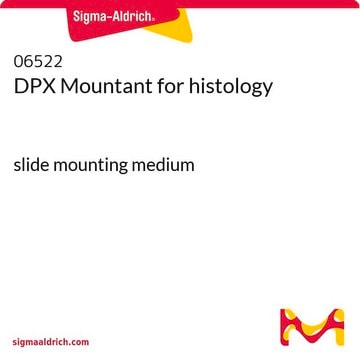Products may be shipped at a different temperature than the recommended long-term storage temperature. If the product quality is sensitive to short-term exposure to conditions other than the recommended long-term storage, it will be shipped on wet or dry-ice. If the product quality is NOT affected by short-term exposure to conditions other than the recommended long-term storage, it will be shipped at ambient temperature. As shipping routes are configured for minimum transit times, shipping at ambient temperature helps control shipping costs for our customers. For more information, please refer to the Storage and Transport Conditions document: https://www.sigmaaldrich.com/deepweb/assets/sigmaaldrich/marketing/global/documents/316/622/storage-transport-conditions-mk.pdf
247642
Xilenos
ACS reagent, ≥98.5% xylenes + ethylbenzene basis
Sinónimos:
Mezcla de isómeros de xileno
About This Item
Productos recomendados
grado
ACS reagent
Nivel de calidad
densidad de vapor
3.7 (vs air)
presión de vapor
18 mmHg ( 37.7 °C)
Ensayo
≥98.5% xylenes + ethylbenzene basis
Formulario
liquid
composición
C6H5CH2CH3, ≤25%
lim. expl.
7 %
impurezas
H2SO4, passes test
≤0.003% S compounds
≤0.05% water
residuo de evap.
≤0.002%
color
APHA: ≤10
índice de refracción
n20/D 1.497 (lit.)
bp
137-140 °C (lit.)
mp
-34 °C
densidad
0.86 g/mL at 25 °C (lit.)
cadena SMILES
Cc1ccc(C)cc1.Cc2cccc(C)c2.Cc3ccccc3C
InChI
1S/3C8H10/c1-7-3-5-8(2)6-4-7;1-7-4-3-5-8(2)6-7;1-7-5-3-4-6-8(7)2/h3*3-6H,1-2H3
Clave InChI
MVZVDAGWAAZJPE-UHFFFAOYSA-N
¿Está buscando productos similares? Visita Guía de comparación de productos
Descripción general
Aplicación
- In the tetraphosphine/palladium-catalyzed Suzuki cross-coupling with sterically hindered aryl halides and arylboronic acids to synthesize tri-ortho-substituted biaryl adducts.
- For the N-alkylation of amines or ammonia with alcohols to synthesize N-alkyl amines.
- To synthesize aromatic polyimides by reacting unsymmetric phosphinated diamines and dianhydrides via solution polymerization.
Envase
Palabra de señalización
Danger
Frases de peligro
Consejos de prudencia
Clasificaciones de peligro
Acute Tox. 4 Dermal - Acute Tox. 4 Inhalation - Aquatic Chronic 3 - Asp. Tox. 1 - Eye Irrit. 2 - Flam. Liq. 3 - Skin Irrit. 2 - STOT RE 2 - STOT RE 2 Inhalation - STOT SE 3
Órganos de actuación
Central nervous system,Liver,Kidney, hearing organs, Respiratory system
Código de clase de almacenamiento
3 - Flammable liquids
Clase de riesgo para el agua (WGK)
WGK 2
Punto de inflamabilidad (°F)
77.0 °F - closed cup
Punto de inflamabilidad (°C)
25 °C - closed cup
Elija entre una de las versiones más recientes:
¿Ya tiene este producto?
Encuentre la documentación para los productos que ha comprado recientemente en la Biblioteca de documentos.
Los clientes también vieron
-
How is shipping temperature determined? And how is it related to the product storage temperature?
1 answer-
Helpful?
-
-
How can I determine the shelf life / expiration / retest date of this product?
1 answer-
If this product has an expiration or retest date, it will be shown on the Certificate of Analysis (COA, CofA). If there is no retest or expiration date listed on the product's COA, we do not have suitable stability data to determine a shelf life. For these products, the only date on the COA will be the release date; a retest, expiration, or use-by-date will not be displayed.
For all products, we recommend handling per defined conditions as printed in our product literature and website product descriptions. We recommend that products should be routinely inspected by customers to ensure they perform as expected.
For products without retest or expiration dates, our standard warranty of 1 year from the date of shipment is applicable.
For more information, please refer to the Product Dating Information document: https://www.sigmaaldrich.com/deepweb/assets/sigmaaldrich/marketing/global/documents/449/386/product-dating-information-mk.pdfHelpful?
-
-
What are the dissimilarities between Xylenes ACS (247642) and Xylenes histological grade (534056)?
1 answer-
The term "histological grade" does not have a precise definition; it simply indicates that the intended use for the product is in histology. For a histological grade product, the company selling the product sets the product specifications. In the case of xylene, there is no direct testing performed to ensure the product provides suitable performance in a wide range of histological procedures.
On the other hand, if a product is sold to ACS specifications, it means that any company selling an ACS grade of chemical must meet the specifications set forth by the American Chemical Society (ACS). Therefore, it should not make a difference as to which company an ACS grade product is sourced from.
It's possible that a histological grade of xylene may not be suitable for some applications, although it is likely suitable for many applications. However, there is an expectation that an ACS grade xylene should be suitable for use in histological applications, even though ACS does not include a suitability test for use in histology.
Helpful?
-
Active Filters
Nuestro equipo de científicos tiene experiencia en todas las áreas de investigación: Ciencias de la vida, Ciencia de los materiales, Síntesis química, Cromatografía, Analítica y muchas otras.
Póngase en contacto con el Servicio técnico







